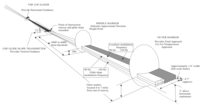
Photo from wikipedia
The delayed operation of distance relays zone-2 element for the faults at the end of the line is excessive. It reduces the fault clearing speed and therefore, is one of… Click to show full abstract
The delayed operation of distance relays zone-2 element for the faults at the end of the line is excessive. It reduces the fault clearing speed and therefore, is one of the main factors that can endanger power system stability. This paper proposes an impedance-based scheme for discrimination between the last 20% of the line length faults and the adjacent line faults, which are covered by the relay zone-2. The suggested non-pilot scheme uses a modified fault location formula for the accelerated zone-2 operation of distance relays. The negative- and zero-sequence components of local signals are utilized to calculate the accurate fault location after the remote circuit breaker (CB) operation. The proposed algorithm is independent of fault resistance, power flow direction, pre-fault condition, and it can clearly distinguish internal faults from the adjacent line faults. Simulation results show that the proposed method can identify the remote CB operation and thus can accelerate the tripping of zone-2 within a very short time for different fault locations, fault types, fault resistances, and load angles. Also, accurate fault location has been achieved under all simulation conditions.
Journal Title: IEEE Transactions on Power Delivery
Year Published: 2021
Link to full text (if available)
Share on Social Media: Sign Up to like & get
recommendations!